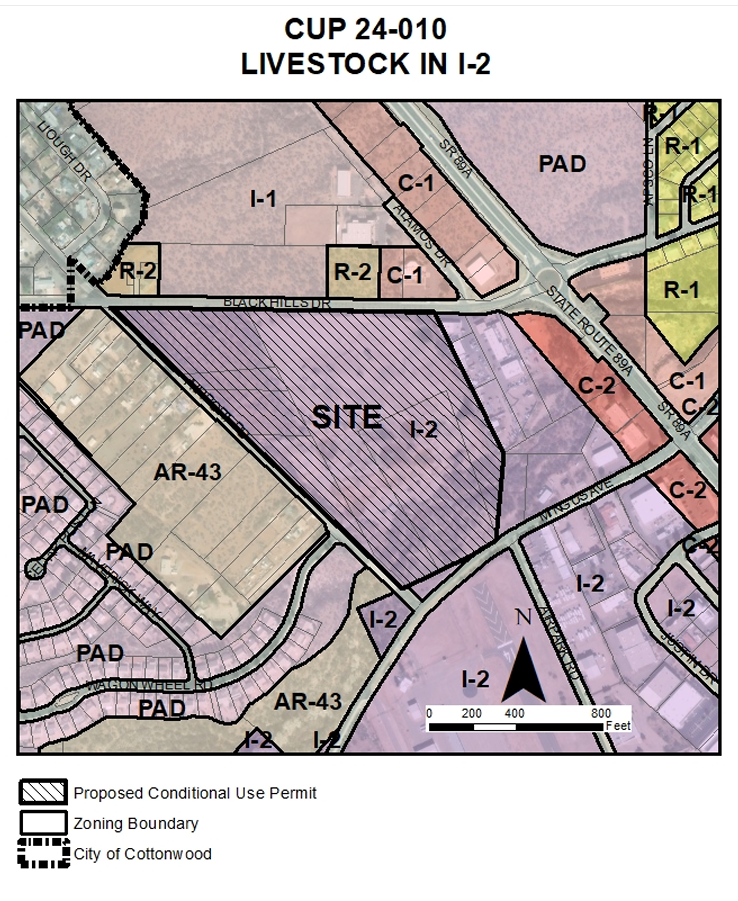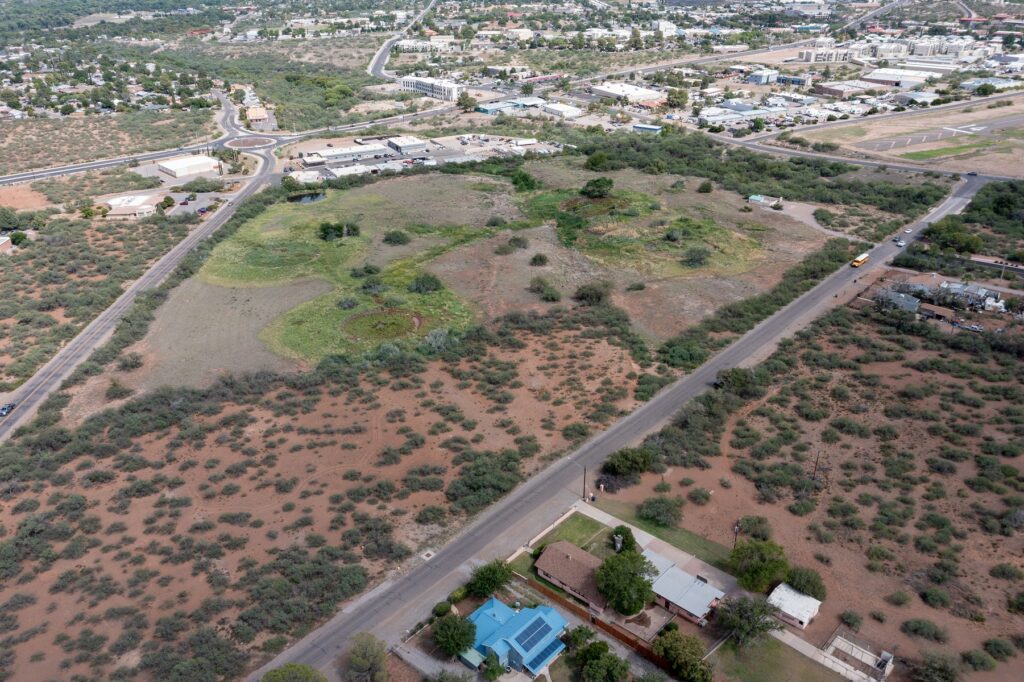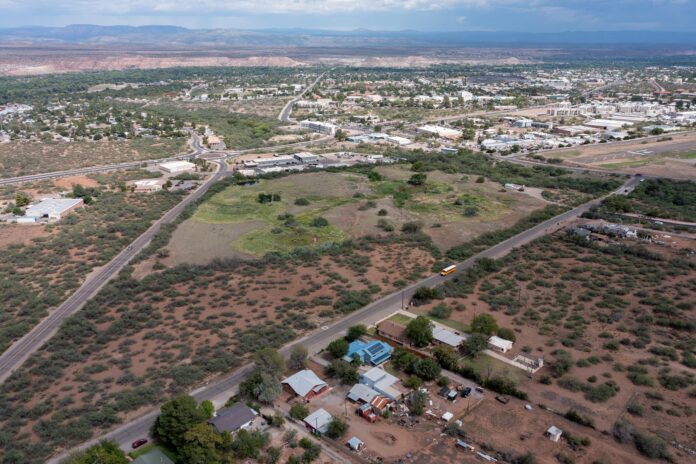The Cottonwood Planning and Zoning Commission approved a conditional use permit to allow Camp Verde rancher K.W. Mulcaire to run a small cattle herd of up to 25 head on the city’s clear zone north of the Cottonwood airport during its Aug. 19 meeting.
The vote was 4-1 with Commissioner Bob Rothrock dissenting.
Irrigation by Effluent Assistant Utilities Director Debbie Breitkreutz explained to the commission that the city currently uses the property for spray irrigation of treated effluent from the city’s wastewater plant.
“We bring in a million gallons a day, we have to get rid of a million gallons,” Breitkreutz said. “You’ll notice that it’s pretty green all year round.” As a result, city staff struggle to keep up with maintenance on the parcels, which total roughly 31 acres and are currently zoned I-2 Heavy Industrial.
“It takes our staff approximately a week, five to six days, for somebody out there on a mower to actually mow the entire thing,” Breitkreutz said.
She estimated the cost in staff time at approximately $800 each time the property requires mowing, which is typically every two months. “We don’t want to put a grass killer out there because that’s not going to do anything for our soil conditions or groundwater.” An additional problem, Breitkreutz said, is soil compaction resulting from more than 20 years of irrigation.

“We have tried to till it or aerate it once long ago, and it ended badly,” Breitkreutz said. “We tore up more stuff than we fixed … We need that soil turned over to some extent … There is a very large crust on that, and we’re just hoping we can open it up to get the water in there.” “New grass doesn’t even grow in there in most spots” due to the compaction, Mulcaire said. “When you get this crust in there, it’s very damp. It’s like picking up a piece of mold. In that mold, what do you get? You get fly larva, you get mosquito larva, you get all kinds of bugs.” Aerating the soil properly, he explained, would work to eliminate flies, mosquitoes and cockroaches.
To provide a single solution to problems of weed control and soil aeration, Breitkreutz proposed allowing Mulcaire to run between 18 and 25 cattle on the property for roughly nine to 10 months out of the year depending on vegetation conditions. Mulcaire said they would rotate the cattle off the property at intervals in order to manage regrowth.
“How much excrement would those 25 cows produce on a daily basis?” Commissioner James Glascott asked.
“I don’t really count that that often,” Mulcaire said. “It’s not a feedlot, so we’re not going to have big, giant piles of manure.” He informed the commission that they would harrow the parcel at intervals to work the manure into the soil as fertilizer. “Your grasses are going to become healthier, your land is going to become healthier.” “There’s no issue with concentrating cattle into an area like that along a wash, contamination?” Commissioner George Gehlert asked.
“Not that I’m aware of,” Breitkreutz said.
Rothrock asked if grazing was allowed elsewhere within the city limits, and acting city manager and Utilities Director Tom Whitmer confirmed that a CUP already exists to allow cattle on a different parcel in a C-1 Commercial zone off Clark Way.
Senior Planner Gary Davis confirmed that U.S. Forest Service land adjoining the nearby subdivision of Cottonwood Ranch in the opposite direction, to the southwest, is also currently being used for grazing, with cattle able to saunter up to the property line of some backyards along Mesquite Hills Drive.
“Has the city received any complaints about those cattle?” Chairwoman Lindsay Masten asked.
“No,” Davis said.
“Has the city considered sheep?” Rothrock queried.
“With the sheep and the goat proposition, there are a lot of predators in that area,” Breitkreutz said. “With goats and sheep it would have to be totally different fencing … and there would have to be some sort of guardian animal person with them.” “Wouldn’t sheep also create a dust problem?” Vice Chariman Randy Garrison asked. “They’d eat it right down and remove any vegetation.” Gehlert asked what effects Mulcaire imagined the grazing would have on neighboring homeowners.
“I look at it as a positive for a homeowner around this location,” Mulcaire said, citing the fire danger posed by the existing amount of grass on the property, as well as the health hazard created by ticks, chiggers and other insects finding comfortable homes in the overgrowth. He noted that his family is currently running cattle on a similar parcel of irrigated land in Camp Verde at 2760 Melody Lane.
“We graze around numerous homes on South Main Road,” he said. “This is nothing new to us. This is probably a low-stress area.” Public Comment Public comment was divided on the merits of the CUP.
“The cows are fine,” Cottonwood Ranch resident Larry Mitch said, although he expressed concern over the city’s rational management of its treated effluent.
“I have never smelled any larva or insects from that crust, but I certainly have smelled cattle manure, and I certainly have problems with flies and insects,” said Donna Lee, a resident of Cottonwood Ranch. “Within half a mile you can smell and be bothered by flies from cattle.” “I’ve spoken to agency people with knowledge of county grazing policies and practices who have found this proposal to be very odd and concerning, with terms that benefit the rancher more than the city,” said Cottonwood Ranch resident Julie Chapman. She did not specify who the “agency people” to whom she spoke were.
She also said the operation would be “semi-permanent.” Mulcaire’s permit will run for a maximum of three years. Chapman also said that the cattle would require supplemental feed, which she said would be a nuisance, although Mulcaire had already told the commission that they do not provide extra fodder, due to the expense.
In addition, Chapman described the CUP as affecting a “residential area,” although the property is zoned heavy industrial.
Neighbor Karl Waak said the Mulcaire family had done a great deal for the community over the years.
“They have preserved the tradition of the West that we’ve had, which is oviously cattle,” Waak said. “If I maintained my yard like the city maintains that property, I would probably be divorced.” He suggested blocking off certain potential problem areas on the site to avoid complaints if necessary.
Cottonwood Ranch resident Patrick Burkhart asked the commission to table the request in favor of a more “researched approach” and claimed that the total amount of manure being added to the land every year would be between 291,000 and 460,000 pounds. The manure would be replacing at least an equal amount of grass which the cattle would have to consume in order to produce manure.
“This is not a cattleyard and should not be one,” Cottonwood Ranch board president Jim Millis said. “This is a residential area … If you’ve got too much vegetation you need to find another solution.” “I know how bad the mosquitoes and bugs get in my grass, and my grass is not overgrown,” neighbor Ashley Koepnick said. With regard to the prospect of escaping cattle, she said coyotes already roam Cottonwood freely. “I think that a coyote is a little more worrisome than a cow.” As for noise, “they don’t make a lot of noise unless they’re ready to start mating.” Commission Comments The commissioners’ view differed from the public’s.
“It seemed like a win-win situation for everybody,” Gehlert said.
“I think we should look at potentially putting out some requests for proposals to see if other ideas come in before we jump at the first one,” Rothrock said.
“I grew up here, and I grew up looking at half of the property in town having cattle on it,” Garrison said. “Cottonwood Ranch was one of those parcels that used to have cattle on it year-round. It was interesting to be able to drive down the road and interact with the animals … I think this is a great way to take care of the land.” “I think that sometimes when people imagine cattle, they’re imagining something more like a feedlot or a full ranch operation,” Commission Chairwoman Lindsay Masten said. “This to me feels extraordinarily like a trial run … one of the most environmentally-friendly ways that we can manage things.” According to the final stipulations specified by staff and the commission, the permit will run for three years, with a review of its success by the commission to take place after the first 12 months.

Daulton Venglar/Larson Newspapers



